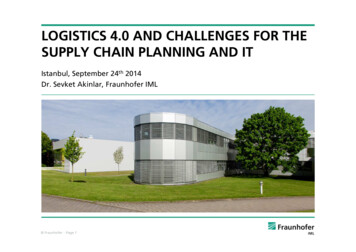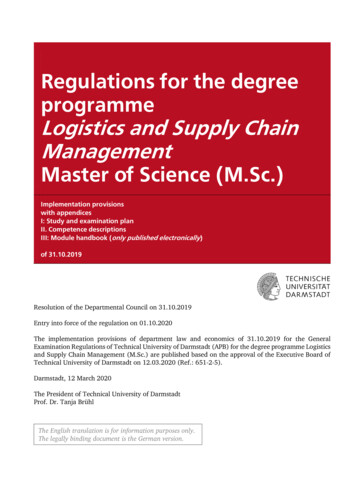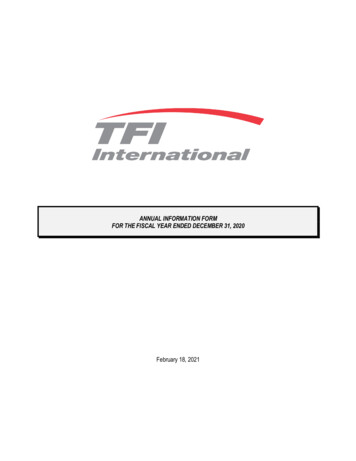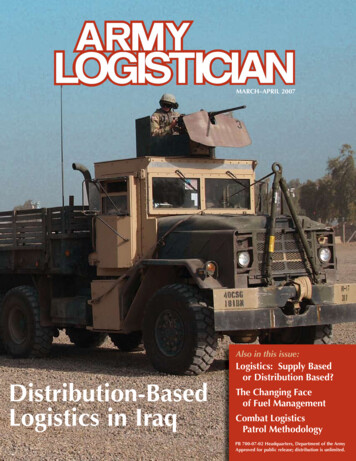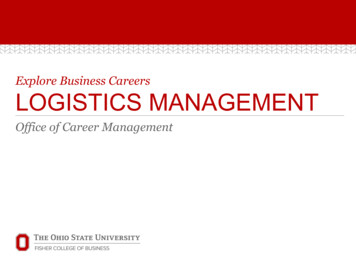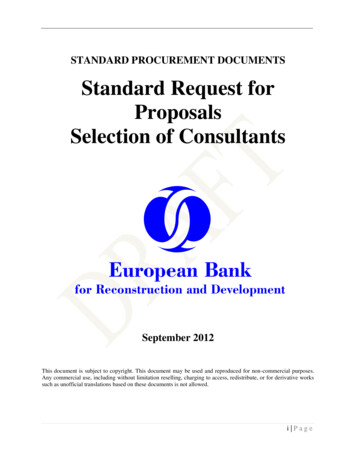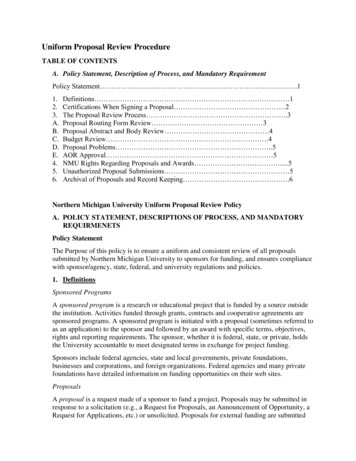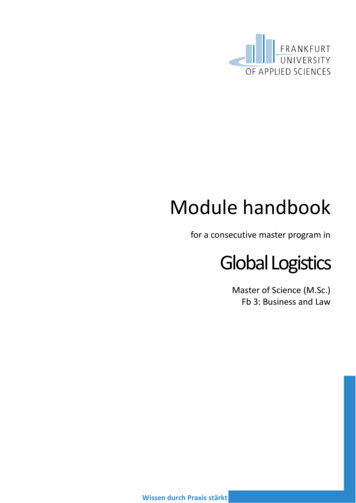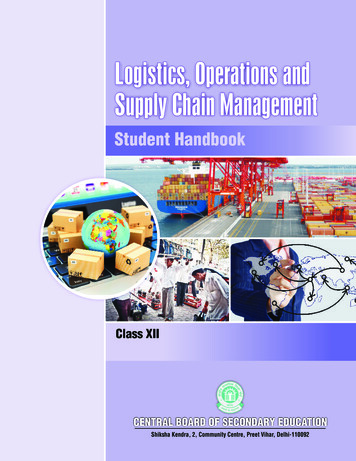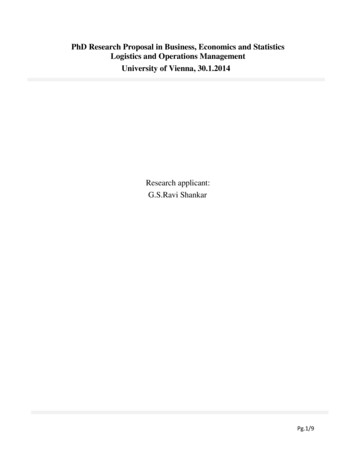
Transcription
PhD Research Proposal in Business, Economics and StatisticsLogistics and Operations ManagementUniversity of Vienna, 30.1.2014Research applicant:G.S.Ravi ShankarPg.1/9
TABLE OF CONTENTS1.Introduction . 31.1.Logistics Management . 32.Transportation & Distribution. 43.Logistic distribution modeling . 44.Research objectives and Conclusion . 5References . 6Appendix . 7List of FiguresFigure1. Integrated Supply chain network. Source [5] . 7Figure2. The implementation path which is commonly followed by European companies. Source:Harrisonand van Hoek, 1999. . 8Figure3. Characteristics of Transportation Modes [1] . 9Figure4. Transportation and Distribution process in Oil & Gas Downstream [7] . 9Pg.2/9
1.IntroductionA successful logistics system could help to improve traffic environment and transportationdevelopment. Since transportation contributes the highest cost among the related elements inlogistics systems, the improvement of transport efficiency could change the overall performanceof a logistics. Transportation plays an important role in logistics system and its activities appearin various sections of logistics processes.The application of logistic model computation and case studies include nonlinearity occurrencesin Ecology, Biology, Environmental Sciences, Aerospace and Oil & Gas. Due to the presence ofglobal and local fluctuations and a lack of precision of measurements, one has to deal witheffects of randomness on such models using stochastic independent modeling and furthervalidation experiments.Logistics and Operational management, here with is discussed in perspective to Oil & Gasapplications. The similar logistic operations and models can be beneficial implemented in otherindustrial sectors.1.1.Logistics ManagementLogistics is ‘part of the supply chain process that plans, implements, and controls the efficient,effective forward and reverse flow and storage of goods, services, and related informationbetween the point of origin and the point of consumption in order to meet customersrequirements’ [1,7]The objective of logistics process management is to get the right quantity and quality ofmaterials to the right place with respect to right time, client, and price.A Supply Chain is a network of facilities that procure raw materials, transform them intointermediate goods and then final products, and deliver the products to customers through adistribution system. Supply Chain Management is the management of flow of materials,information, and funds across the entire supply chain [1].The general concept of an integrated supply chain is often illustrated by a line diagram [A-Fig.1]that links participating firms into a coordinated competitive unit. The figure illustrates ageneralized model adapted from the supply chain management program.Material management is central to manufacturing and trading industry. Material managementforms the internal part of the complete supply chain. Material is sourced, procured, stored,processes or produced, distributed and sold [A-Fig.2].The entire process of logistics deals with the moving of materials (goods movement) into,through, and out of a firm, can be categorized into three areas. (1) Inbound logistics Procurement (2) Internal logistics – Store (3) Outbound logistics – Sales and distributionPg.3/9
2.Transportation & DistributionTransportation accounts for two-thirds of total logistic costs. Transportation increases the timeand place utility of products by delivering them at right time and place. Various options formoving products from one place to another are called transportation modes. Road, rail, air, waterand pipelines are considered the five basic modes of transportation [A-Fig.3]The Transportation and Distribution (TD) application area covers the logistics activities relatedto: Delivery of product from a delivering plant to a customerTransfer of product between two company-owned locationsReceipt of purchased product from a vendorThese activities are carried out across the processes of scheduling, load confirmation, anddelivery confirmation [A-Fig.4]Therefore, transportation is the base of efficiency and economy in business logistics and expandsother functions of logistics system3.Logistic distribution modelingLogistic models encounter uncertainty in which variables or parameters have the probability ofoccurrence, a highly promising technique of solving stochastic optimization problems is therobust programming proposed by Mulvey et al [3]. Logistic planning and management largelyfocus on minimizing the cost associated with producing and distributing products under a varietyof constraints.Considering one product flow of material, the total minimizing cumulative cost is determined.The below example ‘cost-transport’ deterministic logistic model applies for finding costoptimization [8]. This equation will be extended to logistic multi dimensional cross functionalnodal network analysis of transportation and distribution.Eq.(1.1)Notations:xik denotes the amount of raw material shipped from location i to plant k,xk represents the amount of product x produced at plant k,xkj is the amount of product x shipped from plant k to market j,cik denotes the unit cost for raw material shipped from location i to plant k,ck represents the unit cost for producing product in plant k,Pg.4/9
ckj is the unit cost for shipped the product from plant k to market j.The objective function in Eq.(1.1) expresses the cumulative cost which consists of transportation,production, and inventory.4.Research objectives and ConclusionThe research shall minimum focus on the following: Complex supply chains comprise several levels of entities (suppliers, producers, warehouse, clients) and various modes of transport between entities. The goal of the researchis to determine a state of the art in this area and investigate specific applications like Oil& Gas in context of business economics. Computational Logistic distribution modelingLogistic examples and logistic problems will be discussed. Computational distribution oflogistic models will be analyzed to bring robust efficient models, Logistic independenttesting is made using computer programming, results are post processed using scientificexcel and stochastic modeling tool. Complex Transport networks design and optimizationComplex freight transport network involves several modes of transport and transshipmentpoints involving goods or container handling activities (example: for rail/road or surface /maritime transport). The design and optimization of transport networks involve problemssuch as the location of transshipment points in the network, the choice of transport modesand the optimization of flows through the network. The goal of the research is todetermine the problems and methods in this area and focus on one specific applicationsuch as maritime, rail/road networks or inland navigation networks. Inventory - routing problemsIn areas such as petroleum or liquid gas distribution, producers or vendors need toorganize multi routing problems on several days in order to deliver products toconsumers and manage their inventory of products to avoid stock outs. The goal of theresearch is to make a state of the art of problems and models in Oil & Gas sector.Pg.5/9
References[1] Reza Zanjirani Farahani, Shabnam Rezapour, Laleh Kardar, ’Logistics operations andManagement’, Elsevier Publications, ISBN: 978-0-12-385202-1[2] Pierre Dejax, Gunther Fullerer, ‘Modeling and optimization in Logistics and Transport’,Ecole des Mines de Nantes, course no.040335/2 KFK PM/LM Seminar (E)[3] Chian-Son Yu, Han-Lin Li, ‘A robust optimization model for stochastic logistic problems’,International journal of production economics, 2002.[4] Henri Schurz, ‘Modeling, analysis and discretization of stochastic logistic equations’,International journal of Numerical analysis and modeling, vol 4, Institute of scientific computingand information, 2007.[5] Mukesh Shukla, ‘SAP Material Management, Managing, Sourcing, Procurement andInventory with SAP’, Tata McGraw Hill India Private Limited, ISBN: 978-0-07-014446-0.[6] PhD Dissertation, ‘The Position of the Logistics Service Provider within the Supply Chainand the Achievement of Dominance through Customer Relationship Management’, JanusPannonius University, Faculty of Business and Economics.www.gphd.ktk.pte.hu/files/./Josef Michael Zellner tezisfuzet.pdf[7] Enterprise Resource Planning, SAP Labs, ‘Logistics, Supply Chain and OperationsManagement’, www.sap.com[8] Henri Schurz, ‘Modeling, Analysis and Discretization of Stochastic Logistic equations’,Department of Mathematics, Southern Illinois University Carbondale, USA, Print m-05-010Pg.6/9
Appendix.Figure1. Integrated Supply chain network. Source [5]Pg.7/9
Figure2. The implementation path which is commonly followed by European companies.Source:Harrison and van Hoek, 1999.Pg.8/9
Figure3. Characteristics of Transportation Modes [1]Figure4. Transportation and Distribution process in Oil & Gas Downstream [7]Pg.9/9
Logistics and Operational management, here with is discussed in perspective to Oil & Gas applications. The similar logistic operations and models can be beneficial implemented in other industrial sectors. 1.1.Logistics Management Logistics is 'part of the supply chain process that plans, implements, and controls the efficient,
